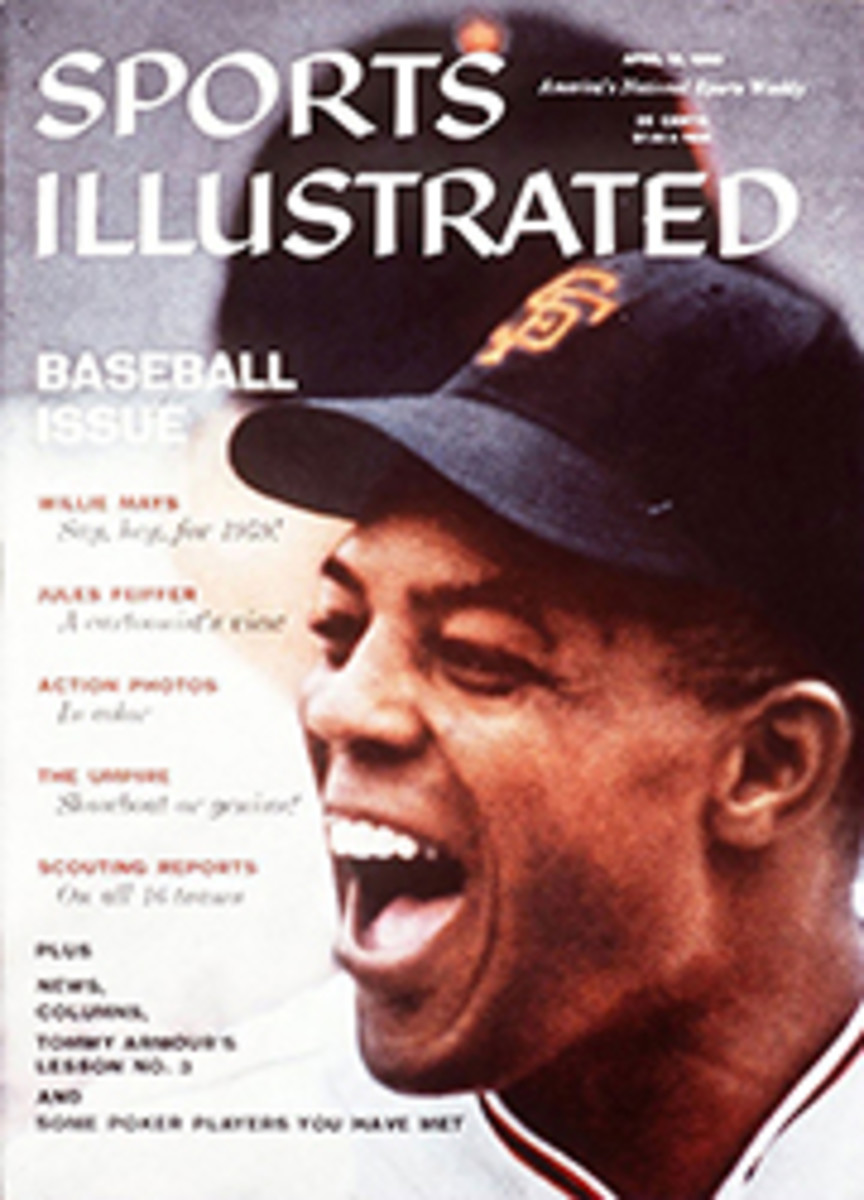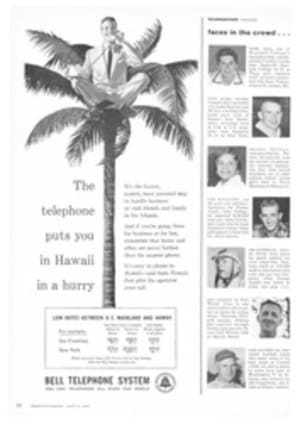
WALL WAS WONDROUS
As a climax to an exciting production, Art Wall's shattering finish in the 1959 Masters tournament was as high an exercise in drama as golf's major competitions have produced. What Wall needed—and got—was an array of five birdies in the last six holes to win by a stroke over Cary Middlecoff. The 25,000 enthusiasts who crowded the Augusta National golf course last Sunday and the millions who caught television's excellent transmission saw Wall, six strokes behind leader Arnold Palmer as the final round began and hardly considered a contending figure at that point, sweep over Augusta's long and difficult course in 66 shots to post a four-round total of 284. This was enough to defeat Arnold Palmer, the indefatigable defending champion, by two strokes, and the final challenger, Cary Middlecoff, by one.
For nine years, though winning his share of tournaments and more than his share of prize money, this quiet but articulate golfer has been one of the overlooked members of the professional circuit. Then this year, at 35, Wall seems abruptly to have reached his competitive maturity. He barely lost the Los Angeles Open to Ken Venturi's final round 63 (SI, Jan. 19), won the Bing Crosby Invitation, finished second in tournaments at Phoenix and Tucson before winning the Azalea Open just before the Masters. The legions who liked Wall but underrated his ability were surprised and pleased that he was doing so well on the circuit. Winning the Masters is ample proof that he is now something even better than a successful circuit golfer.
As the tournament got under way, Wall, despite his Azalea victory, was a lukewarm choice along with favorites Sam Snead (picked because he was Sam Snead) and Ken Venturi (picked because he has made winning the Masters his own particular golfing ambition). But as the tournament boiled into motion, Wall, with Venturi and Snead, faded from the picture. It was the battle between the youthful (29) Palmer, ripping his drives off the tee for tremendous distance, and the tough 44-year-old Canadian Stan Leonard, that provided the focus of attention.
Heavy all-night rains had drenched the course for the first day of play, and Leonard, taking advantage of the moist and holding greens, came in early in the afternoon with a fine 69. This lead held up despite challenges from Palmer, Jack Burke and 45-year-old Chandler Harper, all of whom carded one-under-par 71s. The rest of the field squeezed in tightly behind the four leaders, 55 players scoring between 72 and 77. Modestly nestled in a nine-way tie for 10th place at 73 sat the eventual champion, Art Wall.
In the second round, on a day that was sunny but windy, Palmer turned in a 70 that would have been much higher but for some tenacious scrambling and deft putting (28 putts for the round). On the par-5 8th hole, for instance, pressing to get close to the green with his second shot, he badly topped a wood from the fairway. The ball flew along the ground until it hit a mound at the left hardly 70 yards from the spot from which it had been struck. It caromed high into the air and disappeared into a tree and brush-filled hollow, well short of the green. But Palmer boldly cut short what appeared to be the start of a disastrous round. He went in after the ball, hacked it out and got his par with a good chip and an eight-foot putt. At the end of the day Palmer's two-round total of 141 led Leonard, who faded somewhat with a 74, by two strokes.
For the rest of the field there was no relief from the tight clustering of the scores. Anyone shooting higher than 149 for the first 36 holes, and co-favorite Ken Venturi was among this group, failed to qualify for the final two days of competition. A five-stroke margin, in fact, covered the 40 golfers who qualified behind the two leaders, Palmer and Leonard.
Well back of the lead, in a seven-way tie for 21st at 147, was Art Wall.
During Saturday's round of 18 holes, the once tightly packed field began to shake apart as Palmer and Leonard intensified their duel for the championship. Again, as on the opening day, Leonard came in with a 69 and Palmer with a 71. This tied them for the three-day lead at 212, but Cary Middlecoff, winner of the Masters in 1955 and a two-time U.S. Open champion, fired a crisp 68 to move into serious contention only a stroke back.
As most of the early pursuers tumbled back around him, Wall struggled to maintain position on the ladder. He had had only two days of on-location Masters preparation, and it took him another two days of competition to warm to the event and to the course. In the third round Wall fashioned a 71 to place him in a four-way tie for 13th, still six shots back of the lead.
The pattern established by the first three rounds was maintained until late afternoon on the final day. Palmer, with a par 36 over the first nine holes, had increased his lead to two strokes over Middlecoff and three strokes over a floundering Leonard. Then a flaw in the pattern abruptly emerged. On the 12th Palmer plopped his tee shot into the muddy creek fronting the green and took a triple-bogey 6; yet he seemed to recover with birdies on the par-5 13th and 15th holes.
It was at just about this time that Wall struck—and viciously. Playing two groups back of Palmer, Wall banged a wood to the edge of the 13th and then plunked in a 15-foot putt for his birdie after a chip shot from 80 feet left him short. Twenty feet from the hole on the back edge of the par-4 14th, Wall rolled in his putt for another birdie. On the 15th, millions of televiewers gasped as his putt from 25 feet for an eagle just skirted the edge of the cup, but the next went down for a birdie.
Up ahead Palmer was shaking badly. He missed a two-foot putt on the 17th green to take a bogey 5 there and then, when it seemed that he could clinch the championship with a birdie 3 on the final hole, his first putt from only four feet scooped out of one corner of the hole and he had to settle for a par 4. This opened the gap wide for Wall. He needed one birdie to beat Palmer's final score of 286, but he got two; with a 15-foot putt on the 17th and a 12-footer on the 18th.
It was as well that he did. Just as Wall walked into the clubhouse with his final score of 284, Cary Middlecoff smashed a two-iron just three feet from the hole on the 15th and then tapped in the putt for an eagle 3.
This demonstration of golf under pressure put Cary into a position where a birdie on any one of the last three holes could tie him for the lead, but he wasn't quite up to such a severe assignment. Pars on 16 and 17 preceded a bad approach shot to the 18th hole. On the right-hand fringe 25 feet away Middlecoff stroked the ball boldly for the hole, but it rolled by on the left leaving Wall a most deserving Masters champion.
For Art Wall, winning the Masters meant a first prize of $15,000, among other incalculable benefits; his 1959 total is now $33,000, the most a professional golfer has ever won at this point in the year.
PHOTO
ASSOCIATED PRESS
VICTORY DANCE by the usually reserved Art Wall followed his sinking of the putt that gave him Masters championship and the right to wear the famous green jacket.
PHOTO
GARRY WINOGRAND
TENSE CHALLENGE by Cary Middlecoff failed by narrow margin when he missed tries for birdies on each of the last three holes.
PHOTO
GARRY WINOGRAND
BOLD DEFENSE of Masters title by Arnold Palmer, co-leader after three rounds, buckled under final-day pressure.
PHOTO
GARRY WINOGRAND
SPECTATORS CLOSING IN APPROACH TO GREEN ON SECOND HOLE AT THE AUGUSTA NATIONAL GOLF CLUB WERE ONLY A FRACTION OF A RECORD CROWD, ESTIMATED AT 75,000 FOR THE FOUR-DAY TOURNAMENT, WHICH WATCHED THIS DRAMATIC 1959 MASTERS

